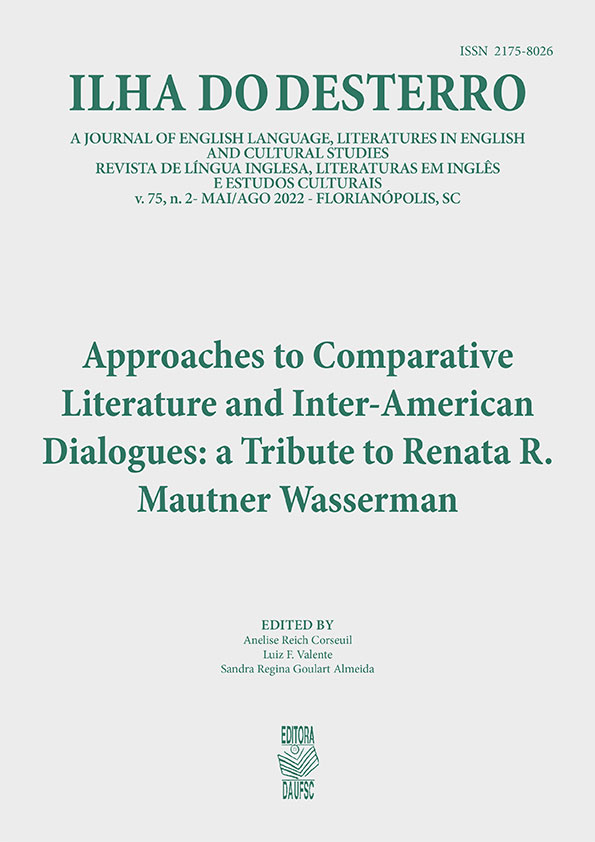Gothic in William Faulkner and Lúcio Cardoso: a comparative reading
DOI:
https://doi.org/10.5007/2175-8026.2022.e85605Keywords:
Gothic, William Faulkner, Lúcio Cardoso, Comparative literatureAbstract
This article aims to analyze the Gothic elements of the short stories “Céu escuro” (1940) – and their related narratives: “Um capítulo de romance” (1940) and “História de Cristiana” (2) (1944) –, by the Brazilian writer Lúcio Cardoso, and “A rose for Emily” (1930), by the American writer William Faulkner. The hypothesis is that the Gothic achievements of both writers, despite their different nationalities, have several similarities, such as: the houses described as loci horribiles and the thematization of family terrors and a decadent rural aristocracy, just to name some. Thus, we seek to prove that the Gothic is a consistent poetic, with identifiable narrative elements. As a theoretical foundation, the works of Júlio França (2020), Fred Botting (2014) and Catherine Spooner (2007) will be used, among others.
References
ARMITT, Lucie. Twentieth-Century Gothic. Cardiff: University of Wales Press, 2011.
BAILEY, Dale. American nightmares; the haunted house formula in American popular fiction. Wisconsin: The University of Wisconsin Press, 1999.
BOSI, Alfredo. História concisa da literatura brasileira. São Paulo: Cultrix, 2017.
BOTTING, Fred. Gothic. Londres: Routledge, 1996.
BOTTING, Fred. Limits of horror; Technology, bodies, Gothic. Manchester: Manchester University Press, 2008.
BOTTING, Fred. Gothic. 2nd. ed. Londres: Routledge, 2014.
CARDOSO, Lúcio. Um capítulo de romance. Diário de Notícias, p. 13-24, nov. 1940.
CARDOSO, Lúcio. Céu escuro. In: Cardoso, Lúcio. Contos da ilha e do continente. Rio de Janeiro: Civilização brasileira, 2012. p. 200-235.
CARDOSO, Lúcio. História de Cristiana (2). In: Cardoso, Lúcio. Contos da ilha e do continente. Rio de Janeiro: Civilização brasileira, 2012. p. 244-7.
CLERY, E. J., MILES, Robert. Gothic documents: a sourcebook 1700-1820. Manchester: Manchester University Press, 2007.
COLAVITO, Jason. Oh the Horror! Why skeptics should embrace the supernatural in fiction. In: COLAVITO, Jason. Horror and Science: essays on the horror genre, skepticsm & scientology, p. 12-18, 2011. E-book. http://www.jasoncolavito.com/free-ebooks.html. Acesso em: 14 set. 2011.
ELIOT, T. S. Poesia. Tradução, introdução e notas de Ivan Junqueira. Rio de Janeiro: Nova Fronteira, 1981.
FAULKNER, William. Uma rosa para Emily. In: HAINIG, Peter (org.). Antologia Macabra. Tradução de Barbara Heliodora e Newton Goldman. Rio de Janeiro: Nova Fronteira, 1972. p. 173-182.
FOLEY, Matt. Gothic 1900 to 1950. In: HUGHES, William; PUNTER, David; SMITH, Andrew. The Encyclopedia of the Gothic. Oxford: Wiley Blackwell, 2016. p. 287-293.
FRANÇA, Júlio. O sequestro do Gótico no Brasil. In: FRANÇA, Júlio; COLUCCI, Luciana. (orgs.) As nuances do Gótico: do Setecentos à atualidade. Rio de Janeiro: Bonecker, 2017. p. 111-124.
FRANÇA, Júlio. O pacto com o Diabo nas raízes da literatura gótica: The Monk, de M. G. Lewis. In: ARAÚJO, Nabil (org.). Refigurações de Fausto; entre literatura e mito. Rio de Janeiro: Makunaima, 2020. p. 108-131.
GROOM, Nick. The Gothic: a very short introduction. Oxford: Oxford University Press, 2012.
KELLY, Michael. Gothic Aesthetics. In: Encyclopedia of Aesthetics, v.2. New York: Oxford University Press, 1998. p. 326-329.
LAMEGO, Valéria. Nota introdutória. In: CARDOSO, Lúcio. Contos da ilha e do continente. Rio de Janeiro: Civilização brasileira, 2012. p. 197-199.
LONGUEIL, Alfred E. The word “Gothic” in Eighteenth Century Criticism. Modern Languages Notes, v. 38, n. 8, p. 453-460, dez. 1923.
MAJLINGOVÁ, Veronika. The Use of Space in Gothic Fiction. Master’s diploma thesis. Department of English and American Studies – Masaryk University, Faculty of Arts, Brno, 2011.
MARSHALL, Bridget. M. Defining Southern Gothic. In: ELLIS, Jay (ed.). Critical Insights; Southern Gothic Literature. New York: Grey House Publishing, 2013. p. 3-18.
MARNIERI, Maria Teresa. Castles, Forests, and Literary Syncretism. An Analysis of Horace Walpole’s The Castle of Otranto. Revista de Lenguas Modernas, n. 28, p. 43-58, 2018.
MATURIN, Charles Robert. Fatal Revenge; or, The Family of Montorio, v. 1. Londres: Longman, Hurst, Rees, and Orme, 1807.
O’CONNOR, Flannery. Alguns aspectos do grotesco na ficção sulista estadunidense. Tradução de Ana Resende e Laís Alves. In: (n.t.) Revista Literária em Tradução, ano 9, n. 18, 1º vol., p. 281-9, jun. 2019.
PUNTER, David. The literature of terror: a history of Gothic fictions from 1765 to the present day. v. 1: the Gothic tradition. Essex: Longman, 1996.
PUNTER, David. The literature of terror; a history of Gothic fictions from 1765 to the present day. v. 2: the modern Gothic. New York: Longman, 1996b.
REEVE, Clara. The old English baron. California: CreateSpace, 2018.
SÁBER, Rogério Lobo. O gótico familiar de William Faulkner e Lúcio Cardoso; formas e dinâmica da opressão. 2020. 196 f. Tese (Doutorado em Estudos Literários) – Faculdade de Letras, Universidade Federal de Minas Gerais, Belo Horizonte, 2020.
SILVA, Daniel Augusto Pereira. A prosa de ficção decadente brasileira e francesa (1884-1924); uma poética negativa. 2019. 132 f. Dissertação (Mestrado em Teoria da Literatura e Literatura Comparada) – Instituto de Letras, Universidade do Estado do Rio de Janeiro, Rio de Janeiro, 2019.
SMITH, Andrew; WALLACE, Jeff. Introduction. In: SMITH, Andrew; WALLACE, Jeff. Introduction. (org.). Gothic Modernisms. Nova York: Palgrave, 2001. p. 1-10.
SPOONER, Catherine. Gothic in the twentieth century. In: SPOONER, Catherine; MCEVOY, Emma. The Routledge Companion to Gothic. New York: Routledge, 2007. p. 38-48.
STEGAGNO-PICCHIO, Luciana. História da literatura brasileira. Rio de Janeiro: Nova Aguilar, 2004.
STEVENS, David. The Gothic tradition. Cambridge: Cambridge University Press, 2000.
Downloads
Published
Issue
Section
License
Copyright (c) 2022 Marina Faria Sena

This work is licensed under a Creative Commons Attribution 4.0 International License.

This work is licensed under a Creative Commons Attribution 4.0 International License.



